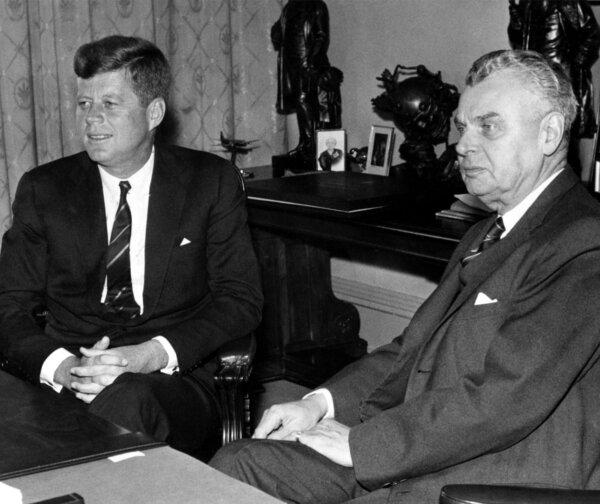Commentary
On the evening of Oct. 22, 1962, President John F. Kennedy made a dramatic appearance on television to announce that the Soviet Union had taken the intolerable step of installing offensive missiles in Cuba, just 90 miles from the mainland United States. Kennedy’s appearance was followed shortly after 8 p.m. by Canadian Prime Minister John Diefenbaker, speaking in the traditional setting, the House of Commons.
It was a harrowing moment—the high drama of which many baby boomers remember because as children they were taught how to shelter under their school desks when the bombing started.
One way or another, Diefenbaker got the memo too late. As if to add pressure, Pearson, the veteran diplomat who was now leader of the Opposition, telephoned the prime minister in the evening to urge him to make a statement right away. Having missed the memo but wanting to be statesmanlike, Diefenbaker mentioned the idea of U.N. inspectors.
Historian Graeme Garrard refers to the half-cocked proposal in an upcoming Dorchester Review article: “This well-intentioned, if rather naive, offer was taken by Kennedy to imply that Canada did not trust U.S. claims, which further angered him.”

Prime Minister John Diefenbaker with U.S. President John F. Kennedy in Ottawa in 1961. CP PHOTOS
Sharing a huge airspace over the northern hemisphere, Ottawa and Washington agreed to joint operational control and integrated command of their air and naval forces, answerable to both countries’ chiefs of staff, in turn under civilian government control.
In a crisis, NORAD was supposed to guarantee “the fullest possible consultation between the two Governments on all matters affecting the joint defence of North America” (emphasis added). This was all negotiated by the diplomats in the 1950s. Canada’s air force and navy already cooperated closely with their U.S. and North Atlantic counterparts.
As the crisis mounted, the White House proceeded as if Canada’s cooperation was a matter of course. Canada had seen the evidence gathered by U-2 spy planes a week earlier and knew what was going on.
“In practice,” Garrard points out, “the U.S. administration never seriously consulted Canada during the crisis, NORAD’s first big test.” Not only had “Kennedy unilaterally imposed a quarantine around Cuba without bothering to consult its partner [Canada],” but he “publicly declared that the U.S. Navy and U.S. Air Force would interdict the Soviet ships, by force if necessary.”
Given the scale of the events across the Florida Straits, Washington acted alone. The NORAD and NATO militaries worked closely together. Robinson observes that “there had been time for consultation” but “Kennedy and his advisers preferred to act unilaterally.”

A pair of U.S.-built NORAD F-22 fighter jets fly off the wing of a civilian airplane playing the role of a hijacked airliner over a mountainous area of Alaska, on Aug. 10, 2010. AP Photo/Ted S. Warren
There was another wrinkle in the affair. NORAD had formally asked Ottawa to raise the Canadian military’s alert level to the equivalent of Defcon 3 which was “Increased readiness above that required for normal readiness” with air forces on high alert. Douglas Harkness, Canada’s Defence Minister since 1960, thought it obvious that integrated forces should be at the same alert level.
Only the cabinet could make the decision to raise the “Defcon” alert level and so, of course, Harkness had to check with the prime minister. Given Diefenbaker’s peeved state of mind, the decision, which should have been a no-brainer in such a crisis, became a political football in a farcical cabinet meeting.
Diefenbaker came down against raising the alert level, supported by his idealistic External Affairs Minister Howard Green, who said (I think grandiosely), “If we go along with the Americans now, we’ll be their vassals forever,” as Garrard relates. Since they were under the illusion that Canadian refusal could somehow cool the war fever while asserting Canadian independence, the majority in cabinet sided with Diefenbaker and Green.
But how could the RCAF pilots and Royal Canadian Navy crews, who patrolled the airspace and sea-lanes all year round anyway, be expected to stand by while their partners were on high alert in an existential crisis vis-à-vis the Soviet nuclear threat?
Ignoring the odd duck position the cabinet had put Canada in, Harkness quietly allowed the Canadian military to raise its alert status anyway.
According to Garrard, Diefenbaker and Green were troubled by the “supra-governmental relationship between the Canadian military, in particular the Royal Canadian Air Force, and the Pentagon,” something like an unelected deep state that can only be held accountable by savvy and determined politicians.
But Canada wanted a seat at the table, and NORAD was it: an organization that integrated the defence of North America with the superpower that could afford to do it in the lead.
One lesson learned was that Canada should correct the gap in knowledge and understanding between political leaders and the military. Another would be addressing the civilian bureaucratic disarray that resulted in the prime minister not being properly briefed. A third problem was the overall lack of strategy and forward planning, a perennial missing link in the Canadian psyche.
The correct decision in 1962 was obvious—Canada was “consulted” by virtue of its high-ranking presence at NORAD headquarters in the Rockies. Kennedy could have checked in with Ottawa but disdained the Canadian leader. Given that Kennedy’s compelling TV appearance completely won over Canadian viewers, Diefenbaker’s delay in raising the military alert level looked indecisive and amateurish—just what Pearson’s old enemy wanted to avoid.
Views expressed in this article are opinions of the author and do not necessarily reflect the views of The Epoch Times.
Source link








































Add comment